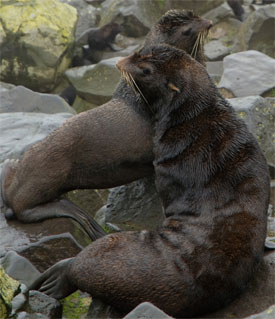
A bald eagle sits atop Unalaska’s Russian Orthodox Church of the Holy Ascension with Esperanza at anchor in background.
(Photo by David E. Guggenheim)
With a Terabyte (1,000 Gigabytes) of high-definition video, photographs and other data, along with numerous biological samples, now making their way around the world to scientists, policymakers and public forums, new insights and perspectives are emerging as the hard work of reviewing this vast volume of new data moves forward. The science team and sub pilots have departed Esperanza, which is continuing west along the Aleutian Island chain, continuing important outreach to local communities. The ship will eventually continue west to Japan.
Before departing Dutch Harbor, the science team/sub pilots made the first public presentation of its findings, including imagery and videos, to the community of Unalaska. The following day, members of the community were invited aboard Esperanza during an Open House to meet with the crew and see the ship up close.

Greenpeace Ocean Specialist, John Hocevar (left) and Greenpeace Oceans Campaigner, George Pletnikov (right) lead community outreach event in Unalaska, Alaska. (Photo by David E. Guggenheim)
Though the at-sea portion of the expedition has concluded, much work lies ahead in the analysis and review of the information collected. In addition, planning is underway for events to bring the new imagery and insights to the public, so stay tuned. Also, the team continues to review chart data regarding the pinnacles reported to be in the Zhemchug Canyon area which purportedly rise within 20 feet of the surface. Such features would certainly be biologically important, so the search will continue.
Pribilof and Zhemchug Canyons revealed diverse and complex ecosystems, rich with corals, sponges, fish and other marine life. They also revealed striking human impacts from trawlers, damage that was documented during the expedition. For a reflection on the conclusion of the expedition, read David Guggenheim’s latest OceanDoctor blog post entitled, “A Sea Turtle is Born in Alaska.”
The Esperanza carried two manned submersibles, a remotely-operated vehicle (ROV) and an international research team to the Bering Sea for a three week survey of Zhemchug and Pribilof Canyons,to map and document deepwater corals living at depths of more than 1,000 feet. The expedition was conceived of and was led by Greenpeace. Read more


 BERING SEA, Alaska — On August 1, 2007, Kenneth Lowyck took his tiny sub to one of the expedition’s “shallower” dives, to about 700 feet into the Bering Sea’s Pribolof Canyon, where he extended the sub’s manipulator arm and collected rock containing a tiny, unassuming white sponge. Months later, there would be no doubt: This was a new species, named Aaptos kanuux, the word “kanuux” being the Aleut word for “heart,” in honor of the Bering Sea’s canyons, considered to be the heart of the Bering Sea. It was the first time the genus Aaptos has ever been documented in the Bering Sea. The discovery comes on the heels of Earth Day and will likely herald future announcements of new species discovered during last summer’s
BERING SEA, Alaska — On August 1, 2007, Kenneth Lowyck took his tiny sub to one of the expedition’s “shallower” dives, to about 700 feet into the Bering Sea’s Pribolof Canyon, where he extended the sub’s manipulator arm and collected rock containing a tiny, unassuming white sponge. Months later, there would be no doubt: This was a new species, named Aaptos kanuux, the word “kanuux” being the Aleut word for “heart,” in honor of the Bering Sea’s canyons, considered to be the heart of the Bering Sea. It was the first time the genus Aaptos has ever been documented in the Bering Sea. The discovery comes on the heels of Earth Day and will likely herald future announcements of new species discovered during last summer’s 






